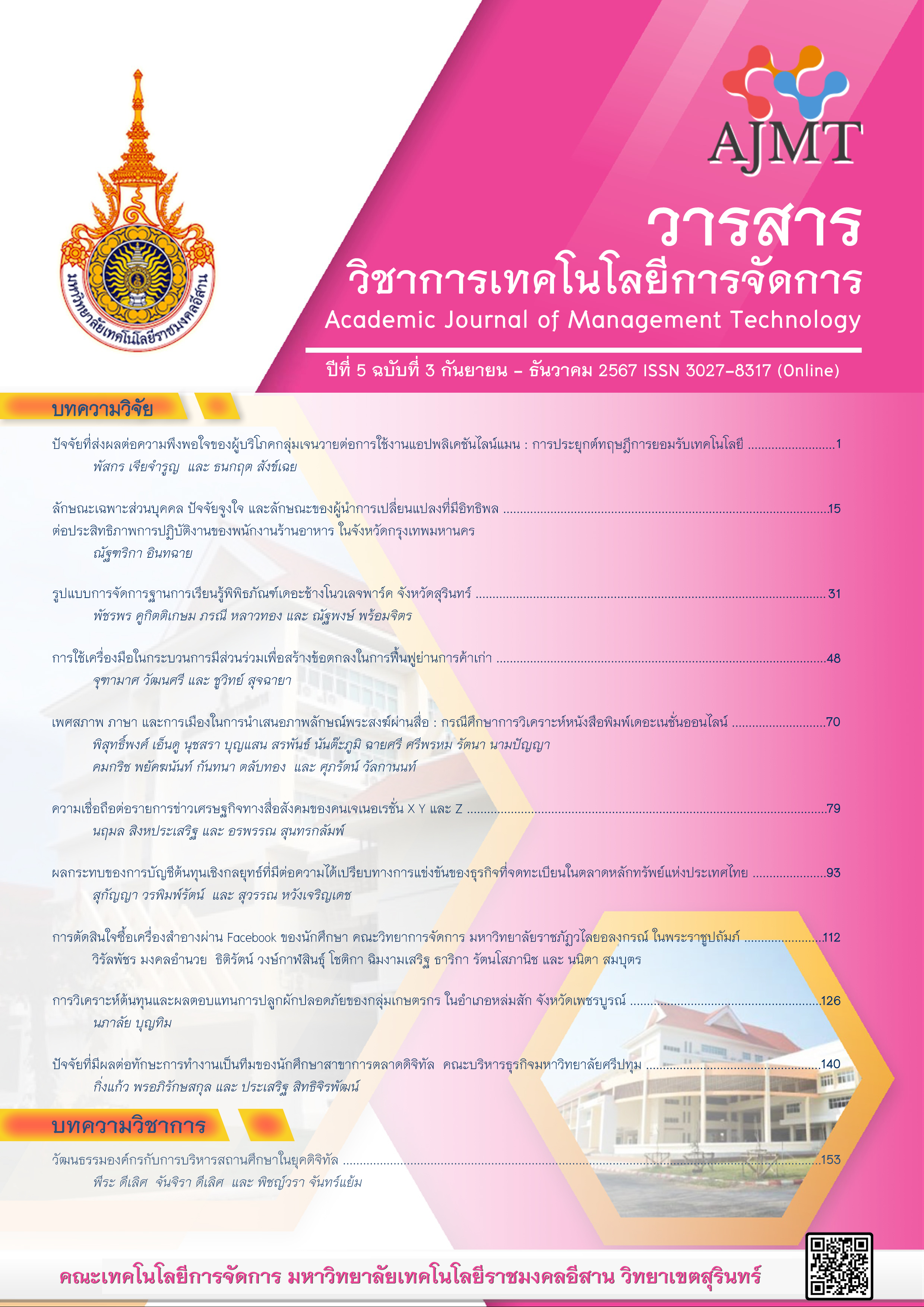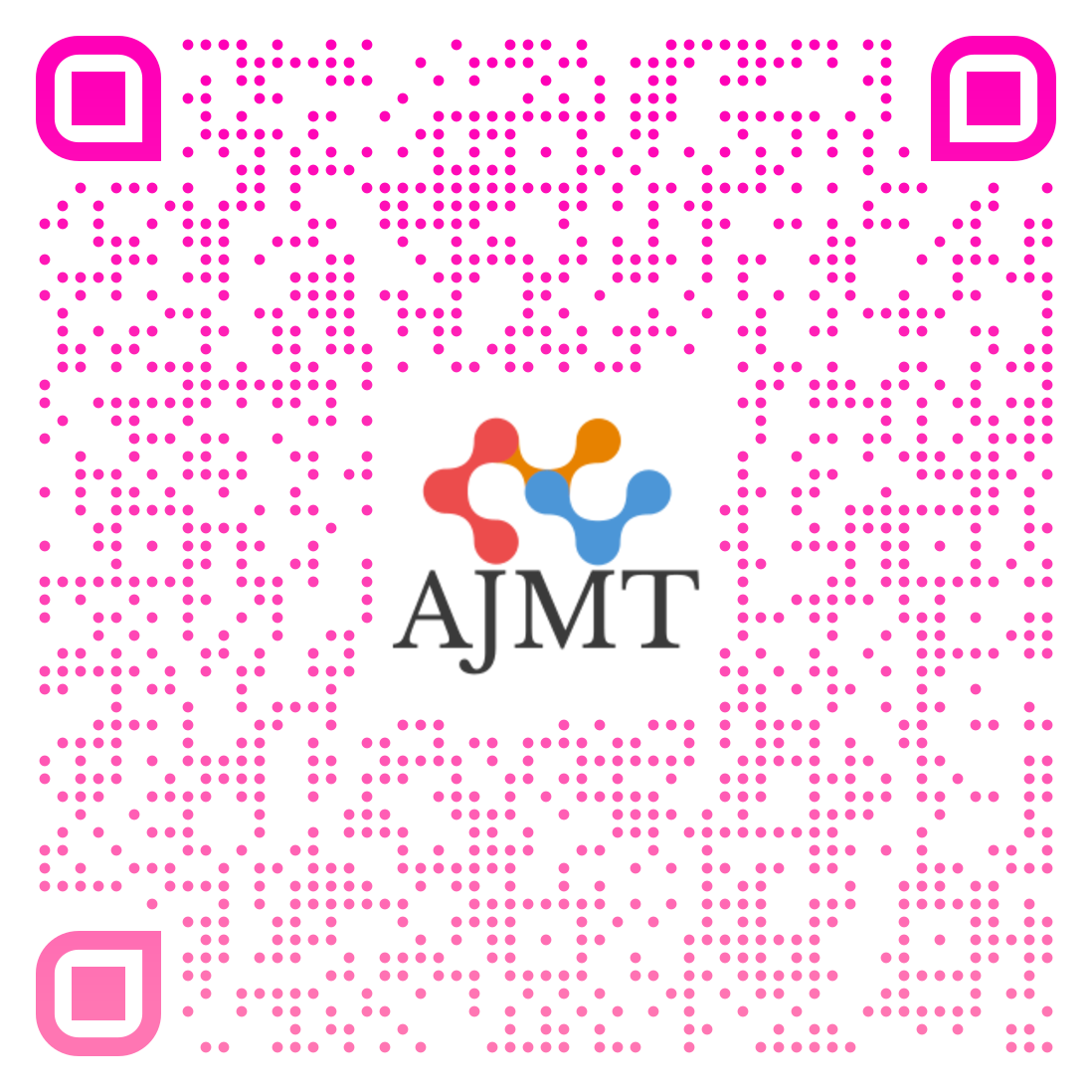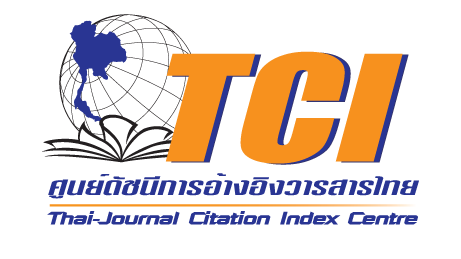เพศสภาพ ภาษา และการเมืองในการนำเสนอภาพลักษณ์พระสงฆ์ผ่านสื่อ : กรณีศึกษาการวิเคราะห์หนังสือพิมพ์เดอะเนชั่นออนไลน์
DOI:
https://doi.org/10.14456/ajmt.2024.26คำสำคัญ:
การนำเสนอผ่านสื่อ , การวิเคราะห์วาทกรรมเชิงวิพากษ์ , พระสงฆ์, เพศสภาพ , อัตลักษณ์ทับซ้อนบทคัดย่อ
การวิจัยนี้เป็นการวิเคราะห์ความสัมพันธ์เชิงซ้อนระหว่างเพศสภาพ ภาษา และการเมืองในการนำเสนอภาพลักษณ์พระสงฆ์ผ่านสื่อในประเทศไทย โดยศึกษาหัวข้อข่าวจำนวน 56 หัวข้อจากหนังสือพิมพ์เดอะเนชั่นออนไลน์ที่เผยแพร่ระหว่างปี พ.ศ. 2556 - 2566 ทำการวิเคราะห์โดยใช้ ทฤษฎีภาษาศาสตร์เชิงเพศสภาพ การวิเคราะห์ วาทกรรมเชิงวิพากษ์ ทฤษฎีการวางกรอบความคิด ทฤษฎีการสื่อสารทางการเมือง และแนวคิดอัตลักษณ์ทับซ้อน ผลการวิจัยแสดงให้เห็นภาพลักษณ์พระสงฆ์ที่ในหลายมุมมอง ซึ่งมีส่วนกำหนดบรรทัดฐานทางสังคม ความคาดหวังทางเพศสภาพ ตลอดจนพลวัตทางการเมือง ผลการวิเคราะห์พบว่า ร้อยละ 65 ของหัวข้อข่าวมีการใช้ภาษาที่สื่อถึง เพศสภาพ โดยมีสัดส่วนการใช้คำสรรพนามเพศชายร้อยละ 78 และเพศหญิงร้อยละ 22 การวางกรอบเนื้อหาเชิงการเมืองคิดเป็นร้อยละ 42 ขณะที่การวางกรอบแบบดั้งเดิม/อนุรักษ์นิยมคิดเป็นร้อยละ 45 นอกจากนี้ยังพบการใช้ภาษาที่ยังคงยึดเพศชายเป็นศูนย์กลางในการนำเสนอวิถีชีวิตสงฆ์ แม้ว่าการรายงานข่าวเกี่ยวกับการบวชของสตรีจะเพิ่มขึ้นร้อยละ 10 ต่อปี ซึ่งสะท้อนถึงพัฒนาการของวาทกรรมด้านเพศสภาพ เมื่อเปรียบเทียบกับงานวิจัยที่ผ่านมา พบความต่อเนื่องของแนวโน้มเดิมและการเปลี่ยนแปลงที่กำลังเกิดขึ้น โดยเฉพาะในมิติการนำเสนอเพศสภาพ ซึ่งสื่อมีบทบาทสำคัญในการต่อรองพื้นที่ของพระพุทธศาสนาในสังคมไทยร่วมสมัยโดยพยายามสร้างดุลยภาพระหว่างคุณค่าดั้งเดิมกับแนวคิดสมัยใหม่ การศึกษานี้ช่วยให้เกิดความเข้าใจเชิงปฏิสัมพันธ์ระหว่างการนำเสนอผ่านสื่อกับมุมมองทางสังคมด้านเพศสภาพและศาสนาในประเทศไทย พร้อมข้อเสนอแนะสำหรับผู้ปฏิบัติงานด้านสื่อ ผู้กำหนดนโยบาย และสถาบันศาสนา
เอกสารอ้างอิง
Al-Hejin, B. (2015). Covering Muslim women: Semantic macrostructures in BBC news. Discourse & Communication, 9(1), 19 - 46. https://doi.org/10.1177/1750481314555262
Baker, P. (2014). Using corpora to analyze gender. Bloomsbury Academic.
Bednarek, M., & Caple, H. (2017). The discourse of news values: How news organizations create newsworthiness. Oxford University Press.
Bennett, W. L. (1983). News : The politics of illusion. Longman.
Buripakdi, A. (2020). English language media and Thai cultural identity : A case study of The Nation newspaper. Asian Englishes, 22(3), 288 - 305. https://doi.org/10.1080/13488678.2019.1669301
Chirasombutti, V., & Diller, A. (2018). Who’s “we,” who’s “other”? Linguistic and social exclusion in Thai media discourse. Journal of Language and Politics, 17(1), 89 - 111. https://doi.org/10.1075/jlp.17003.chi
Cho, E. (2020). The representation of Buddhist nuns in South Korean media : A critical discourse analysis. Asian Journal of Women’s Studies, 26(3), 358 - 379. https://doi.org/10.1080/12259276.2020.1818705
Chongkittavorn, K. (2019). Media, politics and democracy in Thailand. In M. J. Montesano, T. Chong, & M. Heng (Eds.), After the coup : The National Council for Peace and Order era and the future of Thailand (pp. 183 - 200). ISEAS-Yusof Ishak Institute.
Crenshaw, K. (1989). Demarginalizing the intersection of race and sex : A black feminist critique of antidiscrimination doctrine, feminist theory and antiracist politics. University of Chicago Legal Forum, 1989(1), 139-167.
Endoo, P. (2024). Lead news coverage of Buddhist monks in The Nation Online Newspaper : A syntactic analysis [Unpublished research project]. Rajamangala University of Technology Isan, Surin Campus.
Entman, R. M. (1993). Framing : Toward clarification of a fractured paradigm. Journal of Communication, 43(4), 51 - 58. https://doi.org/10.1111/j.1460-2466.1993.tb01304.x
Fairclough, N. (1989). Language and power. Longman.
Fairclough, N. (1995). Media discourse. Edward Arnold.
Goffman, E. (1979). Gender advertisements. Harvard University Press.
Graber, D. A. (1984). Mass media and American politics. Congressional Quarterly Press.
Hoover, S. M., & Lundby, K. (Eds.). (1997). Rethinking media, religion, and culture. Sage Publications. Itoh, M. (2013). The origin of the controversy and the background of the ordination. Japanese Religions, 38(1 - 2), 11 - 27.
Jerryson, M. (2018). If you meet the Buddha on the road : Buddhism, politics, and violence. Oxford University Press.
Kabilsingh, C. (2011). Thai Women in Buddhism. Parallax Press.
Kawanami, H. (2013). Renunciation and empowerment of Buddhist nuns in Myanmar-Burma : Building a community of female faithful. Brill.
Keyes, C. F. (1995). The golden peninsula: Culture and adaptation in mainland Southeast Asia. University of Hawaii Press.
Lakoff, R. (1975). Language and woman’s place. Harper & Row.
Lazar, M. M. (2005). Politicizing gender in discourse : Feminist critical discourse analysis as political perspective and praxis. In M. M. Lazar (Ed.), Feminist critical discourse analysis: Gender, power and ideology in discourse (pp. 1 - 28). Palgrave Macmillan.
Falk, M. L. (2007). Making Fields of Merit: Buddhist Female Ascetics and Gendered Orders in Thailand. NIAS Press.
Falk, M. L. (2015). Post-tsunami recovery in Thailand : Socio-cultural responses. Routledge.
Lövheim, M. (Ed.). (2013). Media, religion and gender : Key issues and new challenges. Routledge.
McCargo, D. (2012). The changing politics of Thailand’s Buddhist order. Critical Asian Studies, 44(4), 627 - 642. https://doi.org/10.1080/14672715.2012.738544
McDaniel, J. T. (2011). The Lovelorn Ghost and the Magical Monk : Practicing Buddhism in modern Thailand. Columbia University Press.
McNair, B. (2011). An introduction to political communication (5th ed.). Routledge.
Michelsen, N. & Woodward, M. (2021). Religion and politics in Southeast Asia: A critical introduction. Routledge.
Mossberger, K., Tolbert, C., & McNeal, R. S. (2007). Digital citizenship : The internet, society, and participation. The MIT Press. https://doi.org/10.7551/mitpress/7428.001.0001
Roemsri, J. (2023). Media literacy among youth in Sakon Nakhon Province. Academic Journal of Management Technology, 4(2),188 - 197. https://doi.org/10.14456/ajmt.2023.13
Ross, K. (2010). Gendered media : Women, men, and identity politics. Rowman & Littlefield.
Schedneck, B. (2021). Buddhist tourism in Asia : New prospects and challenges. University of Hawaii Press.
Scott, D. (2009). Buddhism and Islam on the Silk Road. University of Pennsylvania Press.
Sinnott, M. J. (2012). Borders, diaspora, and regional connections : Trends in Asian “queer” studies. The Journal of Asian Studies, 71(4), 1047 - 1068.
https://doi.org/10.1017/S0021911812001301
Starling, J. (2019). Guardians of the Buddha’s home : Domestic religion in contemporary Jōdo Shinshū. University of Hawaii Press.
Sunderland, J. (2006). Language and gender : An advanced resource book. Routledge.
Tannen, D. (1990). You just don’t understand : Women and men in conversation. William Morrow and Company.
Tewksbury, D. & Scheufele, D. A. (2019). News framing theory and research. In M. B. Oliver, A. A. Raney, & J. Bryant (Eds.), Media effects: Advances in theory and research (4th ed., pp. 51 - 68). Routledge.
Van Dijk, T. A. (1988). News as discourse. Lawrence Erlbaum Associates.
Van Dijk, T. A. (2008). Discourse and power. In R. Wodak & M. Meyer (Eds.), Methods of critical discourse analysis (pp. 61 - 74). SAGE Publications.
Vatikiotis, M. (2017). Blood, Sweat and Tears: The Political Evolution of Buddhism in Thailand. Journal of Southeast Asian Studies, 48(1), 135-148.
Wood, J. T. (2009). Gendered lives : Communication, gender, and culture (8th ed.). Wadsworth Cengage Learning.
Yao, J. (2022). Digital religion in Asia : Social media and religious change in Singapore. Routledge.
ดาวน์โหลด
เผยแพร่แล้ว
รูปแบบการอ้างอิง
ฉบับ
ประเภทบทความ
สัญญาอนุญาต
ลิขสิทธิ์ (c) 2024 คณะเทคโนโลยีการจัดการ มหาวิทยาลัยเทคโนโลยีราชมงคลอีสาน วิทยาเขตสุรินทร์

อนุญาตภายใต้เงื่อนไข Creative Commons Attribution-NonCommercial-NoDerivatives 4.0 International License.
บทความที่ได้รับการตีพิมพ์เป็นลิขสิทธิ์ของคณะเทคโนโลยีการจัดการ มหาวิทยาลัยเทคโนโลยีราชมงคลอีสาน วิทยาเขตสุรินทร์
ข้อความที่ปรากฏในบทความแต่ละเรื่องในวารสารวิชาการเล่มนี้ เป็นความคิดเห็นส่วนตัวของผู้เขียนแต่ละท่านไม่เกี่ยวข้องกับคณะเทคโนโลยีการจัดการ มหาวิทยาลัยเทคโนโลยีราชมงคลอีสาน วิทยาเขตสุรินทร์ และคณาจารย์ท่านอื่นๆในมหาวิทยาลัยฯ แต่อย่างใด ความรับผิดชอบองค์ประกอบทั้งหมดของบทความแต่ละเรื่องเป็นของผู้เขียนแต่ละท่าน หากมีความผิดพลาดใดๆ ผู้เขียนแต่ละท่านจะรับผิดชอบบทความของตนเองแต่ผู้เดียว










